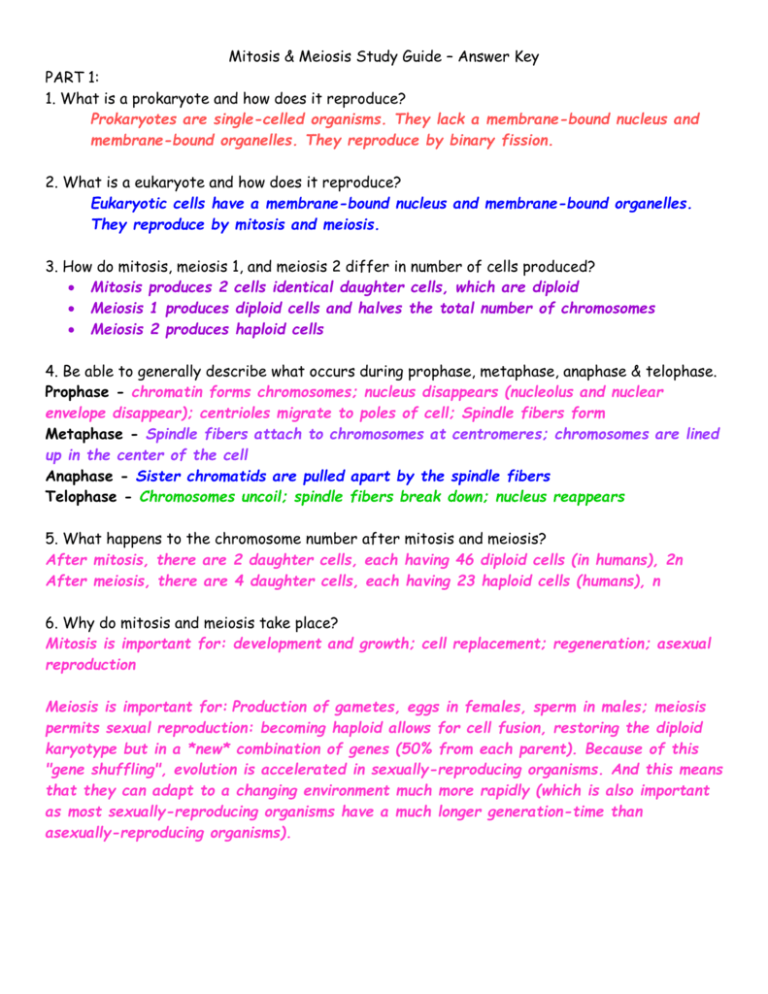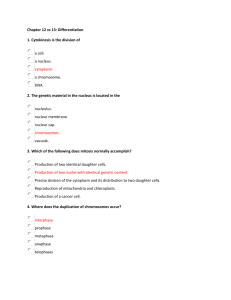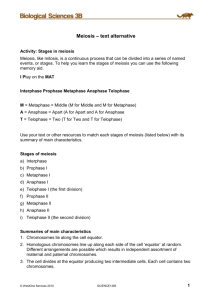Mitosis & Meiosis Study Guide – Answer Key PART 1: 1. What is a
advertisement

Mitosis & Meiosis Study Guide – Answer Key PART 1: 1. What is a prokaryote and how does it reproduce? Prokaryotes are single-celled organisms. They lack a membrane-bound nucleus and membrane-bound organelles. They reproduce by binary fission. 2. What is a eukaryote and how does it reproduce? Eukaryotic cells have a membrane-bound nucleus and membrane-bound organelles. They reproduce by mitosis and meiosis. 3. How do mitosis, meiosis 1, and meiosis 2 differ in number of cells produced? Mitosis produces 2 cells identical daughter cells, which are diploid Meiosis 1 produces diploid cells and halves the total number of chromosomes Meiosis 2 produces haploid cells 4. Be able to generally describe what occurs during prophase, metaphase, anaphase & telophase. Prophase - chromatin forms chromosomes; nucleus disappears (nucleolus and nuclear envelope disappear); centrioles migrate to poles of cell; Spindle fibers form Metaphase - Spindle fibers attach to chromosomes at centromeres; chromosomes are lined up in the center of the cell Anaphase - Sister chromatids are pulled apart by the spindle fibers Telophase - Chromosomes uncoil; spindle fibers break down; nucleus reappears 5. What happens to the chromosome number after mitosis and meiosis? After mitosis, there are 2 daughter cells, each having 46 diploid cells (in humans), 2n After meiosis, there are 4 daughter cells, each having 23 haploid cells (humans), n 6. Why do mitosis and meiosis take place? Mitosis is important for: development and growth; cell replacement; regeneration; asexual reproduction Meiosis is important for: Production of gametes, eggs in females, sperm in males; meiosis permits sexual reproduction: becoming haploid allows for cell fusion, restoring the diploid karyotype but in a *new* combination of genes (50% from each parent). Because of this "gene shuffling", evolution is accelerated in sexually-reproducing organisms. And this means that they can adapt to a changing environment much more rapidly (which is also important as most sexually-reproducing organisms have a much longer generation-time than asexually-reproducing organisms). PART 2: Match each term with its description. A. cytoplasm divided between the two daughter cells B. final phase of mitosis; daughter nuclei reform C. two sister chromatids are joined here D. chromosomes condense and mitotic spindle begins to form E. chromosomes line up in the middle of the cell F. sister chromatids separate, move away to opposite poles G. half of a chromosome in prophase H. another name for sex cell that is formed through meiosis I. daughter cell produced with half the number of chromosomes as parent cell J. daughter cell produced with the same number of chromosomes as parent cell __C___ 1. Centromere __G___ 2. Chromatid __A____ 3. Cytokinesis __E____ 4. Metaphase __H____ 5. Gamete __D___ 6. Prophase __I____ 7. Haploid __B____ 8. Telophase __F____ 9. Anaphase __J____ 10. Diploid PART 3: Stages of Mitosis Plus Interphase The stages of mitosis plus interphase are listed under a-e below. Answer the following questions with reference to these phases. A. Interphase C. Metaphase E. Telophase B. Prophase D. Anaphase 1. During this stage, homologous pairs of chromosomes are lined up in the middle of the cell. C) Metaphase 2. Chromosomes replicate during this phase. A) Interphase 3. Condensation and shortening of chromosomes occurs during this phase. B) Prophase 4. Spindle fibers first appear during this stage. B) Prophase 5. During this phase, the centromeres break apart as the separated sister chromatids begin to move to opposite poles. D) Anaphase 6. Cytokinesis occurs as this phase of mitosis proceeds. E) Telophase 7. During this phase two identical diploid cells are produced. E) Telophase 8. This is the longest part of the cell cycle. A) Interphase PART 4: Stages of Meiosis The stages of meiosis are box. Answer the following with reference to these meiosis. A. Prophase I C. Metaphase II E. Telophase II B. Prophase II D. Anaphase II F. Anaphase I listed in the questions phases of 1. The centromere of each chromosome split, which allows for the sister chromatids to move to opposite ends of the cell. D) Anaphase II 2. Recombination via crossing over occurs during this stage. A) Prophase I 3. By the end of this phase, the homologous chromosomes separate. D) Anaphase II 4. Following this phase, each individual cell is haploid. E) Telophase II 5. During this phase, the chromosomes line up in the center of the cell. C) Metaphase II 6. New genetic combinations, upon which natural selection can act, are present after this stage. A) Prophase I PART 5: Chromosome Numbers Use the chart to answer the following questions: Organism Body Cell (2n) Human 46 Garden Pea 14 Fruit Fly 8 Tomato 24 Dog 78 Chimpanzee 48 Leopard Frog 26 Corn 20 1. 2. 3. 4. 5. 6. 7. Gamete (n) 23 7 4 12 39 24 13 10 What is the diploid number of chromosomes in corn? 20 What is the haploid number of chromosomes in corn? 10 Is the chromosome number related to the complexity of the organism? NO How many pairs of chromosomes do humans have? 23 What process maintains a constant number of chromosomes within a species? Meiosis After Mitosis, how many chromosomes would each daughter cell of a leopard frog have? 26 After Meiosis, how many chromosomes would each daughter cell of a dog have? 39









